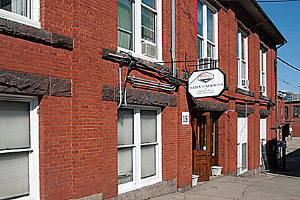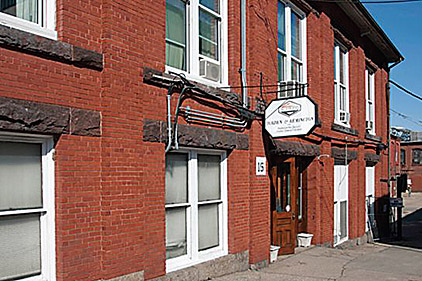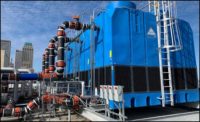
|
|
A new BAS helped Fall River Energy Enterprise reuse buildings and save on energy costs. |
Fast forward to the industrial revolution, a time when Fall River earned the title, “Textile Capital of the World,” and the nickname “Spindle City.” By 1911, the city was recognized as the world’s largest manufacturing port. It was all about coal, then fuel oil, power transmission, electricity, and egregious waste. Hey, our ancestors were hard at work.
In Fall River, “FREE” is the greenest of contemporary acronyms, referring to the Fall River Energy Enterprise. It’s a vision plan that provides the town with a direction for economic revitalization with renewable energy projects such as wind turbines and tidal energy generation and adaptive reuse of historic mills. Ultimately, community leaders seek to position Fall River as a regional leader in renewable energy, hoping to attract new business and create jobs while making the city greener and less dependent on fossil fuels.
“Preservation is the ultimate recycling. It takes about 65 years for a new, energy-efficient building to recover the energy lost in demolishing an existing building,” said Richard Moe, president of the National Trust for Historic Preservation. Preserving and reusing is exactly what one Fall River company is doing with several turn-of-the-century textile mills.
Borden & Remington Corporation, simply referred to as “Boremco,” is a leading national commodity chemical manufacturer. The company’s 26-acre site at the edge of town includes several of the “recycled” textile mills. One of the oldest firms in the community, Boremco recently funded major mechanical system improvements, resulting in a 75% decrease in energy costs.
Previously, a 1950s-installed central steam plant was used to heat all the buildings on the site. The 15 million Btu, gas-fired steam boiler dispatched steam through a leak-plagued distribution system. It provided freeze protection to over 1,000,000 sq ft of manufacturing space. That is, until early in ’09 when Boremco contacted Thermo-Mechanical Systems Corporation, in Assonet, MA.
UP IN SMOKE ... er ... STEAM
“The system was using 10 gallons of condensate makeup water every minute,” said Bob Kelliher, vice president of Thermo-Mechanical, a firm that’s been designing and installing commercial mechanical systems for the past 20 years. Currently, the company has 16 employees, several of whom spent a year on the design phase for the Boremco project.
“The level of waste heat lost through the distribution system equaled five million Btu every hour, or a full third of the boiler’s capacity . . . thrown away,” continued Kelliher.
“We finished the system design and started the installation in the spring of 2010,” said Kelliher. The old steam plant was taken offline and the leaky distribution system was abandoned. Also, management at Boremco decided to consolidate production space.
Unoccupied, beyond repair, and now no longer being heated, two of the buildings are slated for demolition. A few other buildings on the site are rented out as manufacturing space to other companies.
CONTROLS TO THE RESCUE
To replace the steam system, Thermo-Mechanical installed four rooftop units to heat two 110,000-sq-ft buildings. Each rooftop system is a 1.2 million Btu, gas-fired modular Modine. All rooftop units are controlled by a BLMC iWorx module that includes an outdoor reset function with a variable discharge air temperature, and sequential modulation of each multi-stage burner. A single LCI (local control interface) controls all the units from one on-site location.
A key interest of Kelliher’s was the ability to link, control, and monitor all of the new system components. After researching several options, he settled on a plan to install an iWorx, web-based controls system in the two buildings Boremco still inhabits. The iWorx system, by Taco, is a web-based building management, monitoring and control system specifically designed for the light commercial market.
“What makes iWorx different from other systems,” explained Tom Polansky, technical service engineer at Taco, “is that you don’t need special tools, software, or computers to do the installation or commissioning.” Once wired, programs are resident in the controller. By manipulating control parameters for the specific HVAC equipment from a single, central location through the local control interface (LCI), engineering time is eliminated, and installation costs drop significantly.
“Once a controller is wired into the system, you just push a button, and it identifies itself on the network,” continued Polansky. “No control sequences to write, no website to build.”
Boremco maintenance crews were shown how to use the iWorx system, but Thermo-Mechanical remotely monitors the system. “Management at Boremco wanted a hands-off approach to system monitoring,” said Kelliher. “We remotely monitor the system for Boremco. An iWorx system can be set up to e-mail out a message if there is equipment failure or a problem. If the temperature, run time, on/off cycles, or anything else of the sort extends beyond set parameters, we’re immediately notified.”
“This past winter, Boremco’s heating energy costs were less than a quarter of what they were in years before,” said Kelliher. “Of course, some of that is attributed to the decreased heat load by not heating the two buildings, but the energy saved is still staggering.”
SMOOTH SAILING IN CHOPPY WATERS
“The project had its fair share of challenges,” said Dean Haskins, project manager at Thermo-Mechanical. “We laid 5,000 ft of gas line in a 200-year-old facility.” Throughout the trenching process, numerous old utility and pipe lines were crossed, some still in use, others long since abandoned. During the design phase, they also learned that many old roof trusses would need to be repaired before the new, packaged rooftop furnace systems could go up.”
“There’s no doubt that installing the controls system was the easiest part of the job,” said Haskins. “We were all very impressed with how quickly it was installed and brought up for online use. Of all the controls I’ve encountered, iWorx is by far the simplest to install. Commissioning was a piece of cake, just push one little button on the side of the control module, and it’s up and running.”
“We usually plan for three to five days for commissioning the controls system. By lunchtime on the first day, my tech calls me up,” continued Haskins. “I was under the impression they’d have a problem, given the first installation of the iWorx controls. He asked me what to do for the next three days, because commissioning was finished!”
The installation was used as a proving ground for the iWorx controls system. Boremco hopes to put up additional buildings in the near future, to lease out to other tenants. “There’s no question about it,” said Kelliher. “The new buildings will be controlled by iWorx.”


